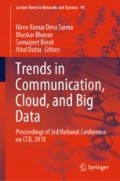Abstract
The tremendous load on the rather archaic medical system in developing countries has necessitated the need to implement artificial intelligence-enabled automated systems to classify different kinds of electrocardiogram (ECG) traces. To this end, we are proposing a novel R-based open-source software with inherent capability to classify different kinds of automated geometric visualizations along with its categorization based upon similarity indices as measured by earth mover’s distance (EMD). This innovative automated software needs verification and validation by clinical practitioners/cardiologists before being implemented to classify large ECG databases to enhance its machine learning capabilities. We anticipate that integration of this robust automated classifier with divergent platforms such as mobile health applications would enable the subjects/patients to continuously monitor the heart rate themselves.
Access this chapter
Tax calculation will be finalised at checkout
Purchases are for personal use only
References
World Health Organization Facts Sheet on Cardiovascular diseases (CVDs) published on 17 May 2017. Last accessed on 12 Nov 2018 http://www.who.int/en/news-room/fact-sheets/detail/cardiovascular-diseases-(cvds)
Gurve D, Srivastava AK, Mukhopadhyay K, Prasad NE, Shukla S, Muthurajan H (2016) Electrocardiogram (ECG) image processing and extraction of numerical information. Int J Eng Technol Sci Res. IJETSR 3(7). ISSN 2394–3386
Obermeyer Z, Emanuel EJ (2016) Predicting the future-big data, machine learning, and clinical medicine. N Engl J Med 375:1216–1219. https://doi.org/10.1056/NEJMp1606181
Rahman QA, Tereshchenko LG, Kongkatong M, Abraham T, Abraham MR, Shatkay H (2015) Utilizing ECG-based heartbeat classification for hypertrophic cardiomyopathy identification. IEEE Trans Nanobiosci 14:1. https://doi.org/10.1109/TNB.2015.2407291
Iranyaz S, Ince T, Gabbouj M (2016) Real-time patient-specific ECG classification by 1-convolutional neural networks. IEEE Trans Biomed Eng 63:664–675. https://doi.org/10.1109/tbme.2015.2468589
Zhang Q, Chen X, Fang Z, Xia S (2016) False arrhythmia alarm reduction in the intensive care unit using data fusion and machine learning. In: 2016 IEEE-EMBS international conference on biomedical and health informatics (BHI), February, Las Vegas, NV. Piscataway, NJ: IEEE, pp 232–235, 24–27 (https://doi.org/10.1109/bhi.2016.7455877)
Cardone-Noott L, Bueno-Orovio A, Minchole A, Zemzemi N, Rodriguez B (2016) Human ventricular activation sequence and the simulation of the electrocardiographic QRS complex and its variability in healthy and intraventricular block conditions. Europace 18(4):iv4–iv15
Chauhan S, Vig L (2015) Anomaly detection in ECG time signals via deep long short-term memory networks. In: 2015 IEEE international conference on data science and advanced analytics (DSAA), 19–21 October. Paris, France. Piscataway, NJ: IEEE, pp 1–7. (https://doi.org/10.1109/dsaa.2015.7344872
Leutheuser H et al (2014) Comparison of real-time classification systems for arrhythmia detection on Android-based mobile devices. In: Conference proceedings of IEEE engineering medical biology society, pp 2690–2693
Ambale-Venkatesh B et al (2017) Cardiovascular event prediction by machine learning: the multiethnic study of atherosclerosis. Circ Res 121:1092–1101. https://doi.org/10.1161/CIRCRESAHA.117.311312
Jeon T, Kim B, Jeon M, Lee B-G (2014) Implementation of a portable device for real-time ECG signal analysis. Biomed Eng Online 13:160. https://doi.org/10.1186/1475-925X-13-160
Rubner Y, Tomasi C, Guibas LJ (2000) The earth mover’s distance as a metric for image retrieval. Int J Comput Vis 40(2):99–121
Lyon A, Mincholé A, Martínez JP, Laguna P, Rodriguez B (2018) Computational techniques for ECG analysis and interpretation in light of their contribution to medical advances. J R Soc Interface 15(138):20170821
Oresko JJ, Jin Z, Cheng J, Huang S, Sun Y, Duschl H, Cheng AC (2010) A wearable smartphone-based platform for real-time cardiovascular disease detection via electrocardiogram processing. IEEE Trans Inf Technol Biomed 14:734–740
AliveCor’s heart monitor for iPhone receives FDA clearance. See https://www.alivecor.com/press/press_release/alivecors-heart-monitor-for-iphone-receives-fda-clearance/. Accessed 4 Dec 2018
PR Newswire Association LLC. AliveCor and Mayo Clinic announce collaboration to identify hidden health signals in humans. See https://www.prnewswire.com/news-releases/alivecor-and-mayo-clinic-announce-collaboration-to-identify-hidden-health-signals-in-humans-300349847.html. Accessed 12 Dec 2018
Wallman M, Smith NP, Rodriguez B (2014) Computational methods to reduce uncertainty in the estimation of cardiac conduction properties from electroanatomical recordings. Med Image Anal 18:228–240. https://doi.org/10.1016/j.media.2013.10.006
Konukoglu E et al (2011) Efficient probabilistic model personalization integrating uncertainty on data and parameters: application to eikonal-diffusion models in cardiac electrophysiology. Prog Biophys Mol Biol 107:134–146. https://doi.org/10.1016/j.pbiomolbio.2011.07.002
Dokos S, Cloherty SL, Lovell NH (2007) Computational model of atrial electrical activation and propagation. In: Conference proceedings IEEE engineering medical biology society 2007, pp 908–911
Adeniran I, MacIver DH, Garratt CJ, Ye J, Hancox JC, Zhang H (2015) Effects of persistent atrial fibrillation induced electrical remodeling on atrial electromechanics—insights from a 3D model of the human atria. PLoS ONE 10:e0142397. https://doi.org/10.1371/journal.pone.0142397
Krueger MW et al (2013) Personalization of atrial anatomy and electrophysiology as a basis for clinical modeling of radio-frequency ablation of atrial fibrillation. IEEE Trans Med Imaging 32:73–84. https://doi.org/10.1109/TMI.2012.2201948
Seemann G, Höper C, Sachse FB, Dössel O, Holden AV, Zhang H (2006) Heterogeneous three-dimensional anatomical and electrophysiological model of human atria. Phil Trans R Soc A 364:1465–1481. https://doi.org/10.1098/rsta.2006.1781
Acknowledgements
This work is supported by a fellowship grant from Indian Council of Medical Research, New Delhi.
Author information
Authors and Affiliations
Corresponding author
Editor information
Editors and Affiliations
Rights and permissions
Copyright information
© 2020 Springer Nature Singapore Pte Ltd.
About this paper
Cite this paper
Shrivastav, K.D. et al. (2020). Earth Mover’s Distance-Based Automated Geometric Visualization/Classification of Electrocardiogram Signals. In: Sarma, H., Bhuyan, B., Borah, S., Dutta, N. (eds) Trends in Communication, Cloud, and Big Data. Lecture Notes in Networks and Systems, vol 99. Springer, Singapore. https://doi.org/10.1007/978-981-15-1624-5_8
Download citation
DOI: https://doi.org/10.1007/978-981-15-1624-5_8
Published:
Publisher Name: Springer, Singapore
Print ISBN: 978-981-15-1623-8
Online ISBN: 978-981-15-1624-5
eBook Packages: EngineeringEngineering (R0)

